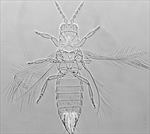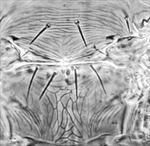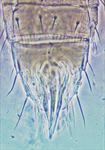
Female

Female

Antenna

Head & pronotum

Mesonotum & metanotum

Tergites V–VIII

Female sternite VI

Fore wing

Male tergite IX (without drepanae)
Both sexes fully winged. Body mainly yellow without dark markings; antennal segments III–VIII grey; major setae pale; fore wings pale. Antennae 8-segmented; III & IV each with forked sense cone. Head wider than long; ocellar triangle and postocular region with closely spaced sculpture lines; three pairs of ocellar setae present, pair III close together between anterior margins of hind ocelli. Pronotum with closely spaced sculpture lines; posterior margin with 4 pairs of setae, S2 prominent and about 40 microns long. Metanotal posterior half with irregular longitudinal reticulations; median setae close to anterior margin; no campaniform sensilla. Fore wing first vein with 3 setae on distal half, second vein with 3 widely spaced setae; posteromarginal cilia wavy. Abdominal tergites III–VI median setae small, close together; II–VIII with lateral thirds covered in closely spaced rows of fine microtrichia, these microtrichial fields with 4 discal setae, posterior margin with fine comb; tergite VIII comb complete, lateral discal microtrichia extend medially; tergite IX with several rows of discal microtrichia. Sternites without discal setae; lateral microtrichial rows scarcely extending mesad of setae S1; posterior margins without comb of microtrichia.
Male smaller than female; tergite IX without paired drepanae; hind femora without comb-like row of stout setae; sternites without pore plates.
Johansen & Mojica-Guzman (1999) provided keys to 37 species from Mexico, but Hoddle et al. (2008) recognised five of these as synonyms of S. perseae, and Mound & Hoddle (2016) placed a further 15 as synonyms of S. citri. Rugman-Jones et al. (2006) produced a molecular key to several pest species in this genus, and relationships between various Scirtothrips species based on molecular data were further considered by Hoddle, Heraty et al. (2008).The genus Scirtothrips currently includes 100 listed species from various parts of the world. Bailey (1964) provided keys to 13 from North America, but that work was based on specimens that were not fully cleared, and thus few structural details were available concerning differences between species. The identity and validity of certain of the species from California requires further study based on freshly mounted, fully cleared specimens.
The native host plant in California is a species of Rhus [Anacardiaceae], although this thrips is known primarily as a pest of Citrus. It breeds on young tissues of leaves and fruits, and pupates on trees or in soil (Grout et al., 1986). Feeding results in distortion of young leaves, and surface scarring on citrus fruits. In Mexico this thrips has been taken commonly in mango orchards.
Widespread in California and Arizona southward through Mexico, specimens from populations in the southern States of the USA across to Florida are very similar in structure.
THRIPIDAE - THRIPINAE
Scirtothrips citri (Moulton)
Euthrips citri Moulton, 1909: 119.
Scirtothrips clivicola Hood, 1957: 49.
Scirtothrips admangiferaffinis Johansen & Mojica-Guzman, 1999: 34.
Scirtothrips apatzinganensis Johansen & Mojica-Guzman, 1999: 37.
Scirtothrips danieltelizi Johansen & Mojica-Guzman, 1999: 44.
Scirtothrips dieterenkerlini Johansen & Mojica-Guzman, 1999: 44.
Scirtothrips hectorgonzalizi Johansen & Mojica-Guzman, 1999: 46.
Scirtothrips magniferraffinis Johansen & Mojica-Guzman, 1999: 48.
Scirtothrips mangoaffinis Johansen & Mojica-Guzman, 1999: 49.
Scirtothrips mangofrequentis Johansen & Mojica-Guzman, 1999: 50.
Scirtothrips mangoinfestans Johansen & Mojica-Guzman, 1999: 51.
Scirtothrips mangomolestus Johansen & Mojica-Guzman, 1999: 52.
Scirtothrips mangonoxius Johansen & Mojica-Guzman, 1999: 54.
Scirtothrips mangorum Johansen & Mojica-Guzman, 1999: 53.
Scirtothrips martingonzalezi Johansen & Mojica-Guzman, 1999: 56.
Scirtothrips novomangorum Johansen & Mojica-Guzman, 1999: 58.
Scirtothrips willihennigi Johansen & Mojica-Guzman, 1999: 67.
Bailey SF (1964) A revision of the genus Scirtothrips Shull (Thysanoptera: Thripidae). Hilgardia 35: 329–362.
Johansen RM, Mojica-Guzman A (1999) The genus Scirtothrips Shull, 1909 (Thysanoptera: Thripidae, Sericothripini), in Mexico. Folia Entomologica Mexicana 104: 23–108.
Hoddle MS, Heraty JM, Rugman-Jones PF, Mound LA & Stouthamer R (2008) Relationships among species of Scirtothrips (Thysanoptera: Thripidae) using molecular and morhphological data. Annals of the Entomological Society of America 101: 491–500.
Hoddle MS, Mound LA, Rugman-Jones PF & Stouthamer R (2008) Synonomy of five Scirtothrips species (Thysanoptera: Thripidae) described from Avocados (Persea americana) in Mexico. Florida Entomologist 91: 16–21.
Mound L & Hoddle M (2016) Scirtothrips species (Thysanoptera, Thripidae) described from mango, Mangifera indica, in Mexico. Florida Entomologist 99 (4):759–764.
Rugman Jones PF, Hoddle MS, Mound LA, & Stouthamer R (2006) Molecular identification key for pest species of Scirtothrips (Thysanoptera: Thripidae). Journal of Economic Entomology 99: 1813–1819.